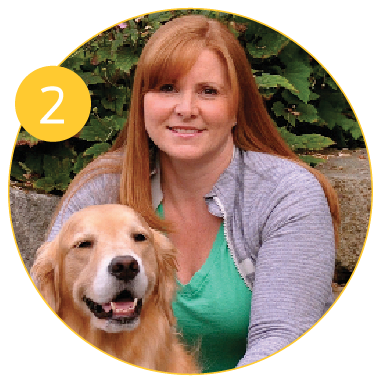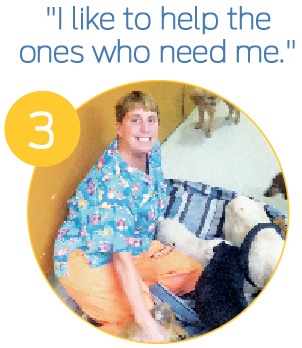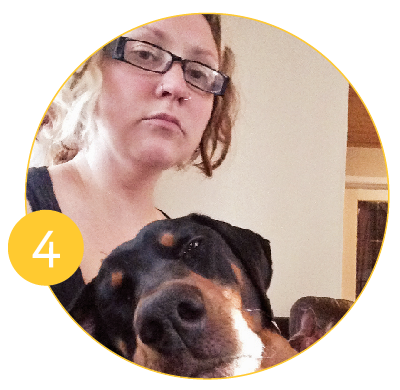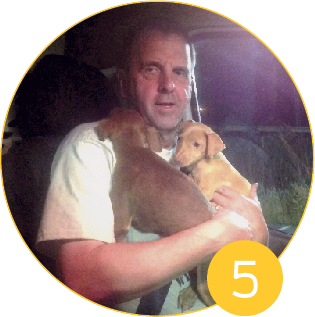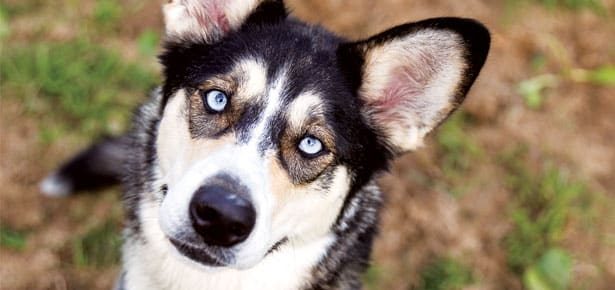
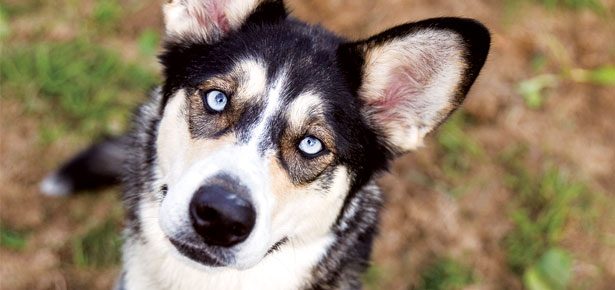
5 Totally Awesome Ways You Can Help Dogs Or Volunteer With Your Own
Five people making a difference, one dog at a time
#1 Take photos to showcase adoptable dogs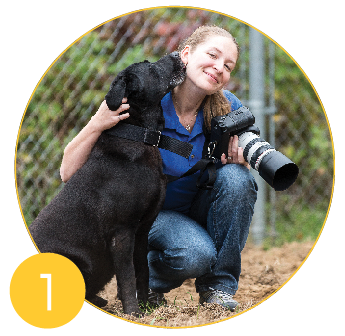
Amanda Griener of Petawawa, Ontario, works as a professional engineer for an Ontario utility. On the weekends, though, she grabs her camera and heads to an OSPCA branch to take fabulous photos of the dogs awaiting adoption, making sure their personalities shine through.
Amanda had been taking photos at weddings and was invited to photograph a special event with the OSPCA. Afterward, she offered her services and now visits the shelter weekly for a photo shoot. To volunteer, Amanda completed a training session on OSPCA values and operating principles. Her weekly visits are two hours long, taking dogs one at a time from their kennels into a large fenced area for off-leash play. Each session lasts about 15 minutes, and Amanda considers it selfish time, as she loves being around the dogs. “It’s a nice escape for me to go out there for an hour or two.”
Although she usually sees a dog only once, there are exceptions, like Bulldozer, a Bulldog pup who jumped out of a pickup truck and required significant surgery. To raise money, Amanda did a larger photo shoot, including before and after shots, and Bulldozer ultimately found his loving forever home.
“You have to be patient and work with them on their terms,” she says. “I collect the dog, get its name, and learn about them, looking for that unique thing I am trying to capture.”
It’s important that she get it right, as the photo is the dog’s opportunity to make a good first impression on adoption web sites or Facebook. “A good quality photo showcases the dog. It’s a great start to find their forever home,” she says.
#2 Lift spirits. Take your dog to visit care homes.
Kerri Andstein hadn’t done much volunteer work since she was a kid in school. Now, the self employed cake artist finds her weekly visit to a care facility in South Surrey, BC, have become an integral part of her life.
Kerri had read Facebook posts about a friend who visited a seniors’ facility with her dog and those stories melted her heart. Kerri researched different organizations and found BC Pets and Friends, “an amazing group.” She applied, and took her own Golden Retriever, four-year-old Roxy, in for an assessment as a therapy dog.
“I was nervous—Golden Retrievers are high energy dogs, but [BC Pets and Friends] explained the testing. They’re not looking to fail people. It put me at ease that I’m not going in thinking my dog isn’t appropriate.”
After completing paperwork, Roxy got a hands-on screening test involving loud or surprising noises, distractions, and touching her paws, ears, and tails for any sensitivities. Roxy passed, so Kerri then attended a four-hour orientation, got a police record check, and was matched to a facility. Kerri visits weekly and loves it; not just the amazing feeling of giving back to the community but also the opportunity to spend more time with Roxy who adores being petted.
“I didn’t realize how much I would enjoy it,” she says. Residents can pat the dog, ask for tricks, or get a cuddle. “Certain residents have an immediate connection. It brightens their day. I can tell it’s the best part of the day for them.”
It’s also a bit of routine—in a good way. It gives residents a reason to keep track of which day it is.
One resident was looking for Kerri and was anxious that she may have missed Roxy’s visit, which is announced on the residents’ bulletin board. Kerri explained that she and Roxy come off the elevator precisely at 10 a.m. on Mondays, and their first visit is the TV room.
“That was six weeks ago. Every time now, the elevator opens and that lady is right there waiting,” says Kerri. “She wants to be first to see Roxy.”
Kerri says it would be easy for people to put up barriers about committing the time it takes to volunteer visiting residential or healthcare facilities, but it’s not a chore. “It’s part of the week I look forward to most. I shut off my phone and am very present with my dog. I put her bandana on and she knows she’s going to work. She’s ready. I find the time—it is that rewarding.”
#3 Start your own rescue group
For Dr. Laurie Hirt, starting her own small scale rescue organization was pretty much all in a day’s work. The practicing veterinarian owns a clinic in Clyde, Ohio and began by taking in dogs that needed a home, and then trying to place them.
“I started rescuing the day I started practice because people got rid of dogs for such silly reasons,” she says. Since 1982, she has been taking dogs, often special needs, as she has the space and the ability to care for their medical needs. In 2009, she officially opened Another Chance Sanctuary, a 501 C nonprofit, out of her home.
Between 28 and 45 dogs live with her at any given time. She places the ones she can, and attends adoption events to give the dogs a better chance of being seen. The other dogs, like the ones with diabetes or epilepsy, or the senior dogs, live with her because she is comfortable living with them and loves their company. “I like to help the ones who need me.”
Nonprofit status allows her to fundraise to help with expenses, while volunteers come twice a day to assist with feeding and cleaning. Her large property provides plenty of opportunity for exercise for all the dogs, including Snoogles, a Shih Tzu with a back injury who gets around, when in his cart, just like any other dog.
“My heart goes out to those animals. They need a place to go, a place to stay. I can’t save everyone and I don’t always…I have to say no sometimes.”
She didn’t say no to Hannah, though, the Golden Doodle born with neurological deficits. Hannah has little control over her rear legs or her ability to go to the bathroom.
“She’s eight. She’s been with me a long time. I get to know the dogs are happy dogs. It makes me happy that I give them a life. I look at Hannah and it would have been a shame if she was put down early on. She’s a fun dog. It’s fun to see her in her cart. She grins at you,” says Laurie, adding that the dogs she rescues “all get a life.”
#4 Take in a dog temporarily
Lindsay Zomers began fostering dogs about five years ago, when she adopted her own pup and became friends with the woman running the rescue, Dhana Metta Rescue Society in Vancouver. She was hooked right from the first dog. “I get to see their progress,” she says. “Fostering gives the dog more one-on-one care.”
She now volunteers with Edmonton, AB’s Animal Rescue and Outreach Society.
Since she began fostering, Lindsay has taken in 50 to 60 dogs and currently has five foster dogs in her care, as well as her own pack. To help dogs that perhaps have a past to overcome, she has even gone to school to become a dog trainer, something she does in addition to working in an office.
“I think, once I did dog training school, I wanted to make sure [the dogs] got the best possible care. I generally take fearful dogs because I have the experience and ability. More fearful dogs speak to me.” Foster dogs live with the family like a family pet.
Foster parents can also be expected to take the dog to adoption events or other appointments and to address any issues that arise. Dogs stay anywhere from a few weeks to a year but for Lindsay, they average three months. The dogs get the love and affection of a real home as well as, in Lindsay’s case, exposure to other dogs; the fosterer gets the opportunity to assess the dog’s temperament and personality while in a home environment (shelters are often stressful for a dog who might react by barking and growling) and the undeniably enormous rewards of having contributed to saving that dog’s life. Plus, foster parents often get to see the dog go into a forever home, and “it’s nice to see you’ve completed someone’s family.”
But fighting the desire to keep a foster dog requires some preparation. “The biggest way to prepare yourself is that if you keep an extra dog, there’s one less dog you can save.”
#5 Road trip! Transport dogs from high kill shelters to rescue groups
As president of a furniture company, Mark Gilbert often volunteered or donated to different causes, but three years ago he became heavily involved with dog rescue, but behind the scenes. Mark transports dogs from high kill shelters to other rescue groups throughout California, Oregon, and Washington, all from his home base in Eugene, OR.
The work involved starts before a dog ever gets inside his Mercedes Sprinter van, which is large enough for him to walk through when loaded with kennels. It is necessary, he says, to have access for safety and clean-up. “It takes about five hours to set up the van,” he says. He knows how many and what size dogs he will be retrieving, so he sterilizes kennels and starts securing them in the vehicle. He repeats this routine three times a month.
“I can get 60 dogs in there, three in a kennel if they’re small dogs. We match dogs up who have previously been kenneled. If they’re scared, they ride in the passenger’s side with me.”
He volunteers with START (Shelter Transport Animal Rescue Team) which has moved more than 5,000 dogs so far. START provides his pickup and delivery destinations (there could be as many as six). He prepares for doggy spills and sickness by rolling up towels and sani-wipes between cages. He also has fans to help circulate the air conditioning from the front to the back of the van.
“I leave around four or five in the morning. I work with the dogs [when arriving at his pickup point] to get them ready,” he says, helping with paper work or veterinarian visits. He sleeps overnight and is up again early “to beat the flies and high temperature in California. It takes an hour to load the van and all are delivered by that evening.”
He was asked, when delivering furniture, if he could move a few dogs, and the first year he moved 60. The second year was 200 and he now does a thousand or more each year. “You stand in front of them looking at them and do whatever you can to help.” He says it isn’t the travel that motivates him to help (it’s the same road over and over again). And being a volunteer driver means you need to be willing to do things without a pat on the back. But he knows exactly what the dogs get out of his efforts. “They get life. You save the ones you can.”
Join the newsletter and never miss out on dog content again!
"*" indicates required fields
By clicking the arrow, you agree to our web Terms of Use and Privacy & Cookie Policy. Easy unsubscribe links are provided in every email.
